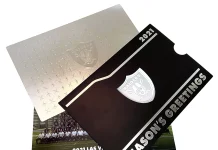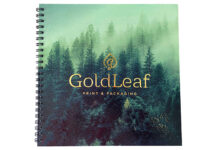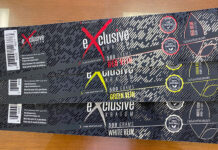by Brittany Willes, PostPress

The phrase “edge staining” likely brings to mind images of bibles and hymnals, their edges gleaming with a metallic gold sheen. However, today’s edge staining goes far beyond traditional books. “Edge staining has become more common,” stated Rick Jennings, co-owner of Kingsport Book, Inc., Church Hill, Tennessee. “Years ago it was journals, hymnals and reference books. The old Merriam-Webster used to be what we call speckle stained. That was edge staining. Today, it’s moved more mainstream, and we’re seeing more and more of it on the trade side.”
Edge staining in itself isn’t a highly technical process, but it does require a certain level of skill in order to maintain consistent coloration and make sure to match what the customer wants. When printers want value add without going as far as edge gilding, the most expensive application, they often opt for edge staining. Kingsport has witnessed an increase in edge staining in the past three to four years, more so out of the trade market as publishers try to differentiate their products on the bookshelves. Despite the increase, few printers have the capability for edge staining. “We provide a service that is still needed on a more limited basis than it used to be, and we do it all by hand,” Jennings said. “We use a basic staining booth and handheld spray guns.”
One of the most unique applications Kingsport has ever done was for a three-volume book set for another publisher. “The customer was publishing a series of limited-edition books and wanted to simulate marbled edges on the pages,” Jennings explained. In order to create the marble effect, Kingsport first created a master on flat paper so the endpapers could be printed with the same pattern. For each book, the spray operator first laid down a base coat of yellow edge stain before sponging the edges with a combination of rust and brown shades. “To bind a book where the endpapers and the page edges contained the same marble design is certainly one of the more unique things weve done over the years,” Jennings said.
Naturally, as the industry has evolved, so has the stain itself. In the past, Kingsport and other printers used dry pigment power and actually mixed the colors. Kingsport still does that today, maintaining a small inventory of dry pigment, but now it has partnered with an ink company that provides the company with water-based pigment colors. Now when customers want a specific color, all they need is a PMS book, and Kingsport can get that stain from the ink company with a PMS number. “It’s a much more exact process than what it was years ago when you had to put in a little yellow, a little blue and red to try to come up the right colors,” Jennings said. The new stain is particularly useful for complex projects.
“Another printer approached us with a series of 34 books, each with a different monotone cover. The publishers wanted the edges of the books stained to match the covers. We used 34 different PMS matches in order to edge stain 34 different colors on 34 different books at one time, one complete series in production back-to-back,” Jennings said. Moving to water-based pigments means increased accuracy when matching colors. Using the PMS system allows customers a reference to the color they want and ensures projects come out how customers expect. “It simplified the process quite a bit,” Jennings affirmed.
The challenge with edge staining is in preparing the edge itself. Printers have to be very careful when trimming any book to be stained. This means making sure any adhesive on the back of the book doesn’t migrate onto the edge of the pages during cover application. If the adhesive is not well cured when it goes through the trimmer, adhesive from the spine gets dragged onto the edges of the pages. On a traditional binding with no edge treatment, it wouldn’t be noticeable. But, because it is water-based, stain will not stick anywhere adhesive has been transferred.
“At the end of the day, it all comes down to the stained edge,” Jennings said. “It’s not an exact science. It’s very dependent on the spray operator to keep everything consistent because it’s all done by hand. It depends on how many passes the operator makes with the spray gun, how far away from the edge of the blocks he holds the spray gun and the settings on the gun to maintain the consistency of color not only around the three edges, but from book to book to book.”
Over the last 20 years, the printing industry has seen more covers with foil stamping and spot UV and embossed covers. According to Jennings, stain plays nicely into that to make the product just a little bit different than what people are used to seeing. “You want to create emotions in people,” Jennings asserted. “You create the most emotion when you can get them to reach into their pocket and pull out money. I think that’s part of what we’re seeing here, trying to create an emotion about something people will pick up and look at.”




